Reflective Analysis on Communicating Methods at Workplace
VerifiedAdded on 2020/05/28
|23
|5393
|112
Report
AI Summary
This report presents a reflective analysis of the student's communication methods in a workplace setting. It begins with an introduction outlining the use of five diagnostic tools: Self-perceived Communication Competence Scale (SPCC), Personal Report of Intercultural Communication Apprehension (PRICA), Nonverbal Immediacy Scale-Self Report (NIS-S), Personal Report of Public Speaking Anxiety (PRPSA), and Talkaholic Scale. The report provides the findings of each tool, analyzing the student's strengths and weaknesses in various communication scenarios, including public speaking, intercultural interactions, and nonverbal communication. Two key communication issues are identified based on the diagnostic results. A literature review is then conducted, focusing on active listening skills and lack of self-reliance, exploring both theoretical and behavioral aspects. The report concludes with a detailed action plan, including short courses, postgraduate studies, conceptual knowledge acquisition, and reflective journaling, along with a Gantt chart to track progress.
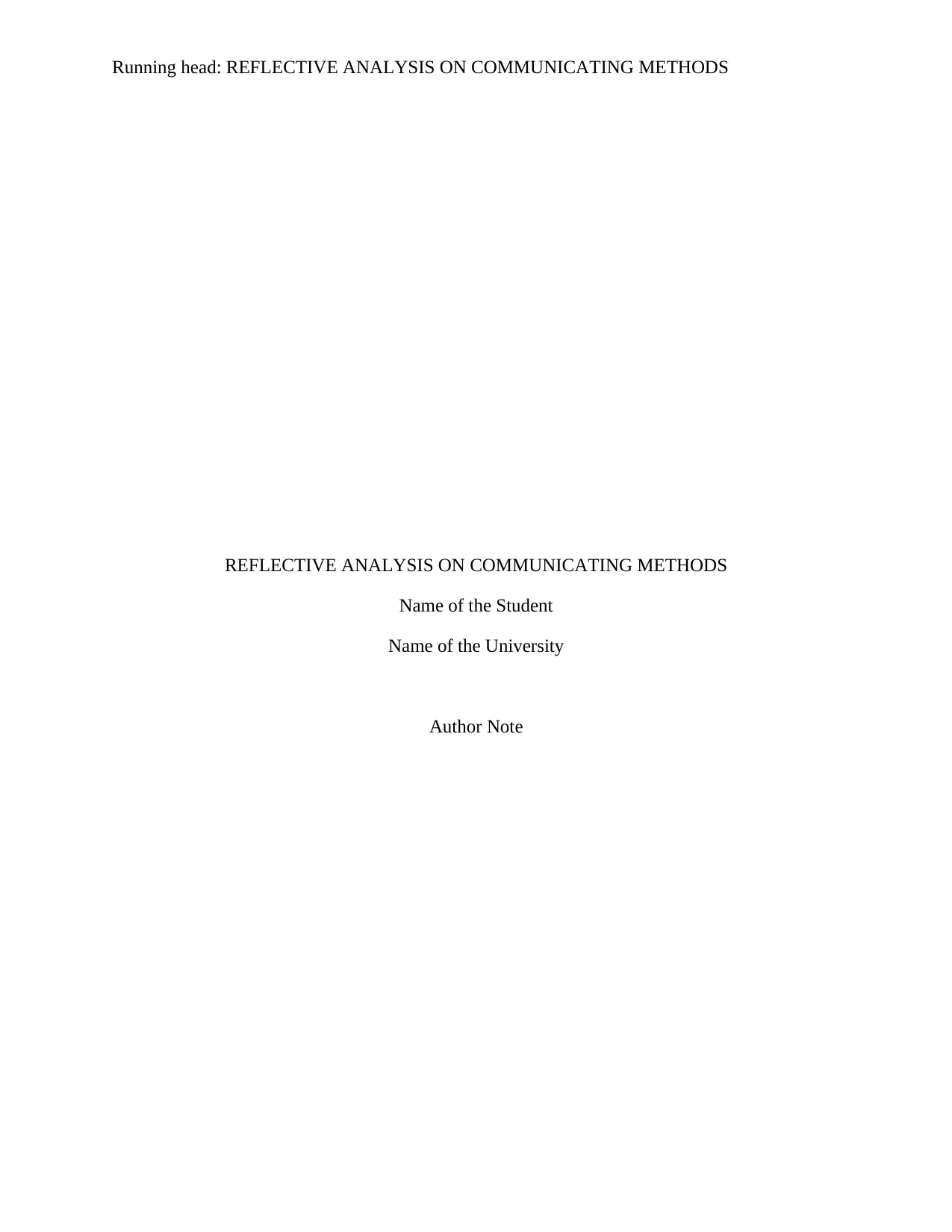
Running head: REFLECTIVE ANALYSIS ON COMMUNICATING METHODS
REFLECTIVE ANALYSIS ON COMMUNICATING METHODS
Name of the Student
Name of the University
Author Note
REFLECTIVE ANALYSIS ON COMMUNICATING METHODS
Name of the Student
Name of the University
Author Note
Paraphrase This Document
Need a fresh take? Get an instant paraphrase of this document with our AI Paraphraser
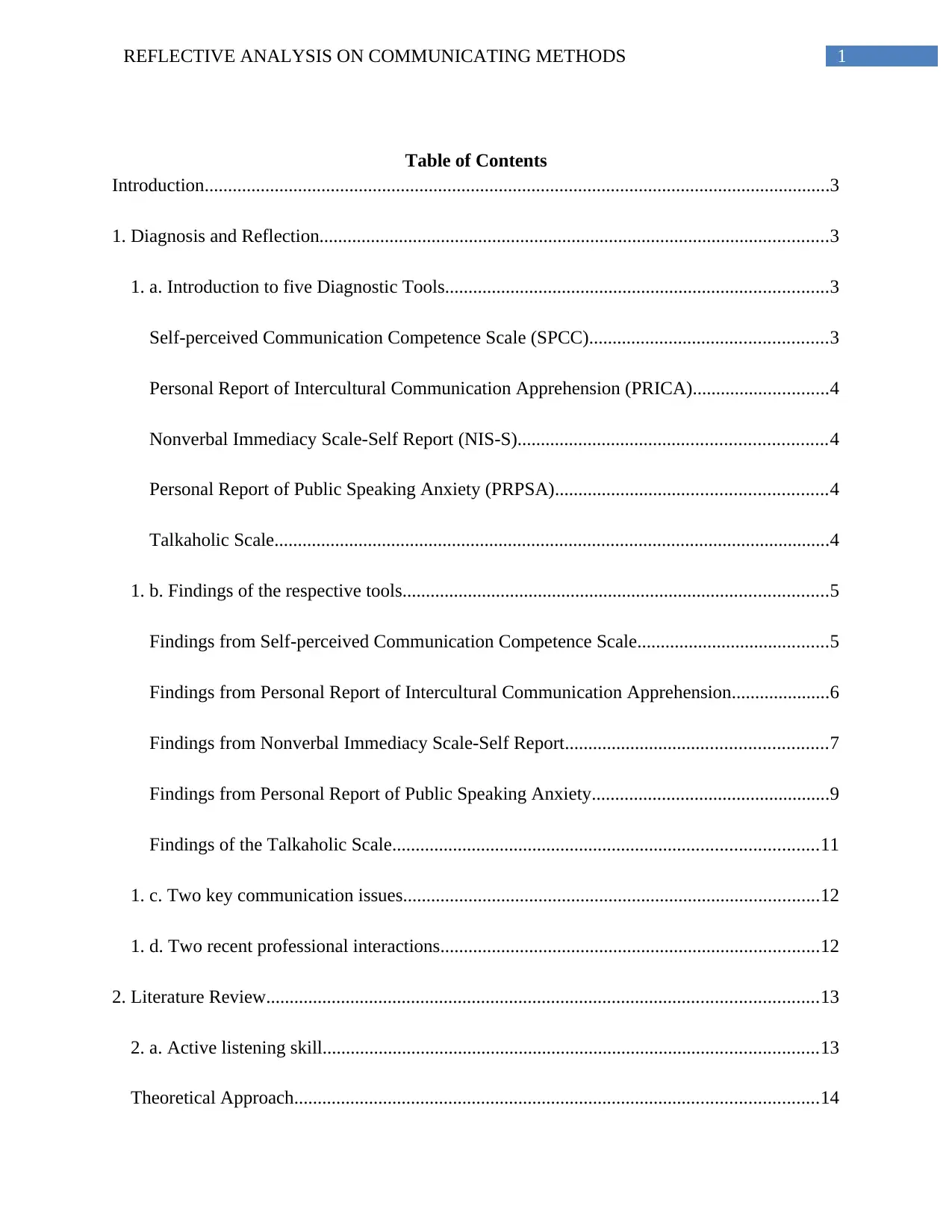
1REFLECTIVE ANALYSIS ON COMMUNICATING METHODS
Table of Contents
Introduction......................................................................................................................................3
1. Diagnosis and Reflection.............................................................................................................3
1. a. Introduction to five Diagnostic Tools..................................................................................3
Self-perceived Communication Competence Scale (SPCC)...................................................3
Personal Report of Intercultural Communication Apprehension (PRICA).............................4
Nonverbal Immediacy Scale-Self Report (NIS-S)..................................................................4
Personal Report of Public Speaking Anxiety (PRPSA)..........................................................4
Talkaholic Scale.......................................................................................................................4
1. b. Findings of the respective tools...........................................................................................5
Findings from Self-perceived Communication Competence Scale.........................................5
Findings from Personal Report of Intercultural Communication Apprehension.....................6
Findings from Nonverbal Immediacy Scale-Self Report........................................................7
Findings from Personal Report of Public Speaking Anxiety...................................................9
Findings of the Talkaholic Scale...........................................................................................11
1. c. Two key communication issues.........................................................................................12
1. d. Two recent professional interactions.................................................................................12
2. Literature Review......................................................................................................................13
2. a. Active listening skill..........................................................................................................13
Theoretical Approach................................................................................................................14
Table of Contents
Introduction......................................................................................................................................3
1. Diagnosis and Reflection.............................................................................................................3
1. a. Introduction to five Diagnostic Tools..................................................................................3
Self-perceived Communication Competence Scale (SPCC)...................................................3
Personal Report of Intercultural Communication Apprehension (PRICA).............................4
Nonverbal Immediacy Scale-Self Report (NIS-S)..................................................................4
Personal Report of Public Speaking Anxiety (PRPSA)..........................................................4
Talkaholic Scale.......................................................................................................................4
1. b. Findings of the respective tools...........................................................................................5
Findings from Self-perceived Communication Competence Scale.........................................5
Findings from Personal Report of Intercultural Communication Apprehension.....................6
Findings from Nonverbal Immediacy Scale-Self Report........................................................7
Findings from Personal Report of Public Speaking Anxiety...................................................9
Findings of the Talkaholic Scale...........................................................................................11
1. c. Two key communication issues.........................................................................................12
1. d. Two recent professional interactions.................................................................................12
2. Literature Review......................................................................................................................13
2. a. Active listening skill..........................................................................................................13
Theoretical Approach................................................................................................................14
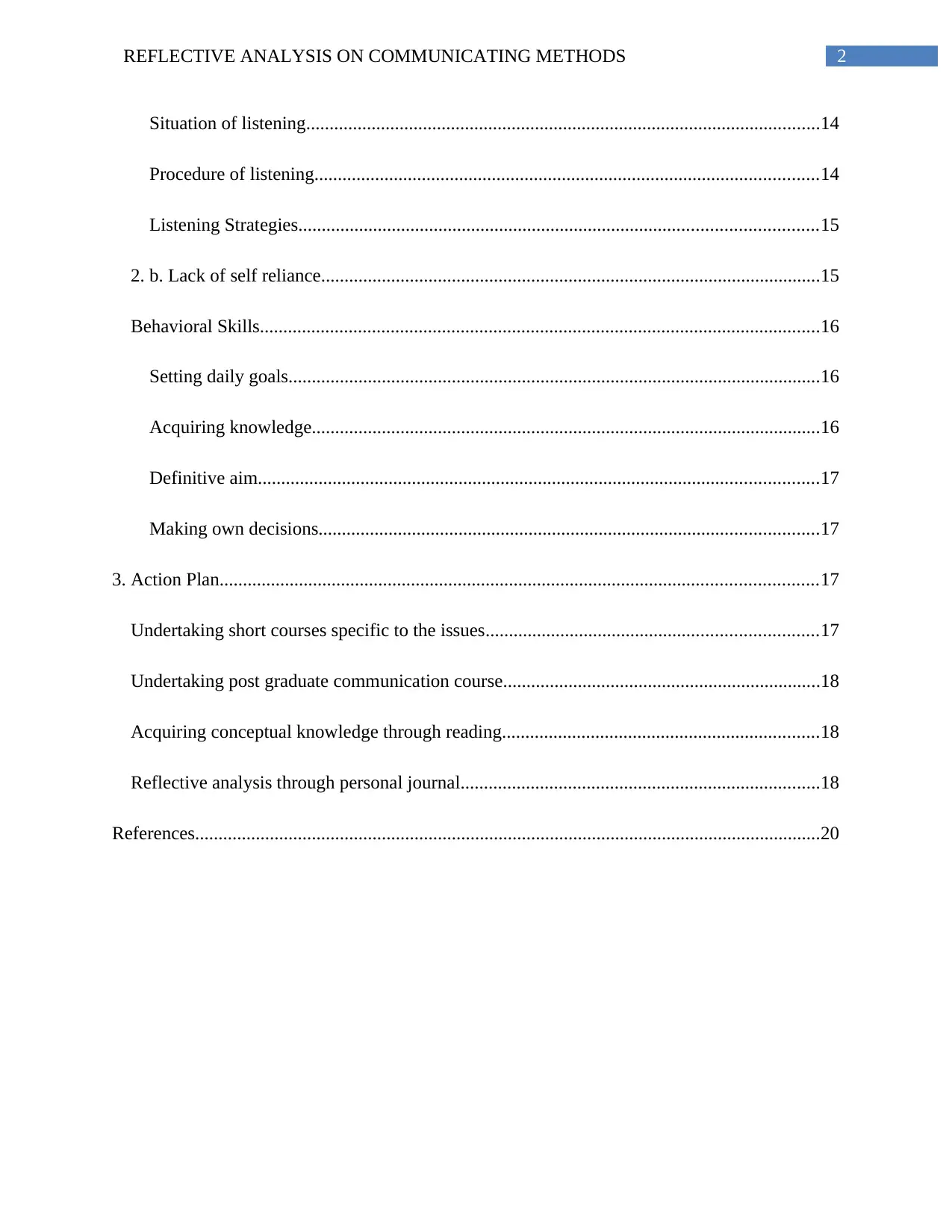
2REFLECTIVE ANALYSIS ON COMMUNICATING METHODS
Situation of listening..............................................................................................................14
Procedure of listening............................................................................................................14
Listening Strategies...............................................................................................................15
2. b. Lack of self reliance...........................................................................................................15
Behavioral Skills........................................................................................................................16
Setting daily goals..................................................................................................................16
Acquiring knowledge.............................................................................................................16
Definitive aim........................................................................................................................17
Making own decisions...........................................................................................................17
3. Action Plan................................................................................................................................17
Undertaking short courses specific to the issues.......................................................................17
Undertaking post graduate communication course....................................................................18
Acquiring conceptual knowledge through reading....................................................................18
Reflective analysis through personal journal.............................................................................18
References......................................................................................................................................20
Situation of listening..............................................................................................................14
Procedure of listening............................................................................................................14
Listening Strategies...............................................................................................................15
2. b. Lack of self reliance...........................................................................................................15
Behavioral Skills........................................................................................................................16
Setting daily goals..................................................................................................................16
Acquiring knowledge.............................................................................................................16
Definitive aim........................................................................................................................17
Making own decisions...........................................................................................................17
3. Action Plan................................................................................................................................17
Undertaking short courses specific to the issues.......................................................................17
Undertaking post graduate communication course....................................................................18
Acquiring conceptual knowledge through reading....................................................................18
Reflective analysis through personal journal.............................................................................18
References......................................................................................................................................20
⊘ This is a preview!⊘
Do you want full access?
Subscribe today to unlock all pages.

Trusted by 1+ million students worldwide
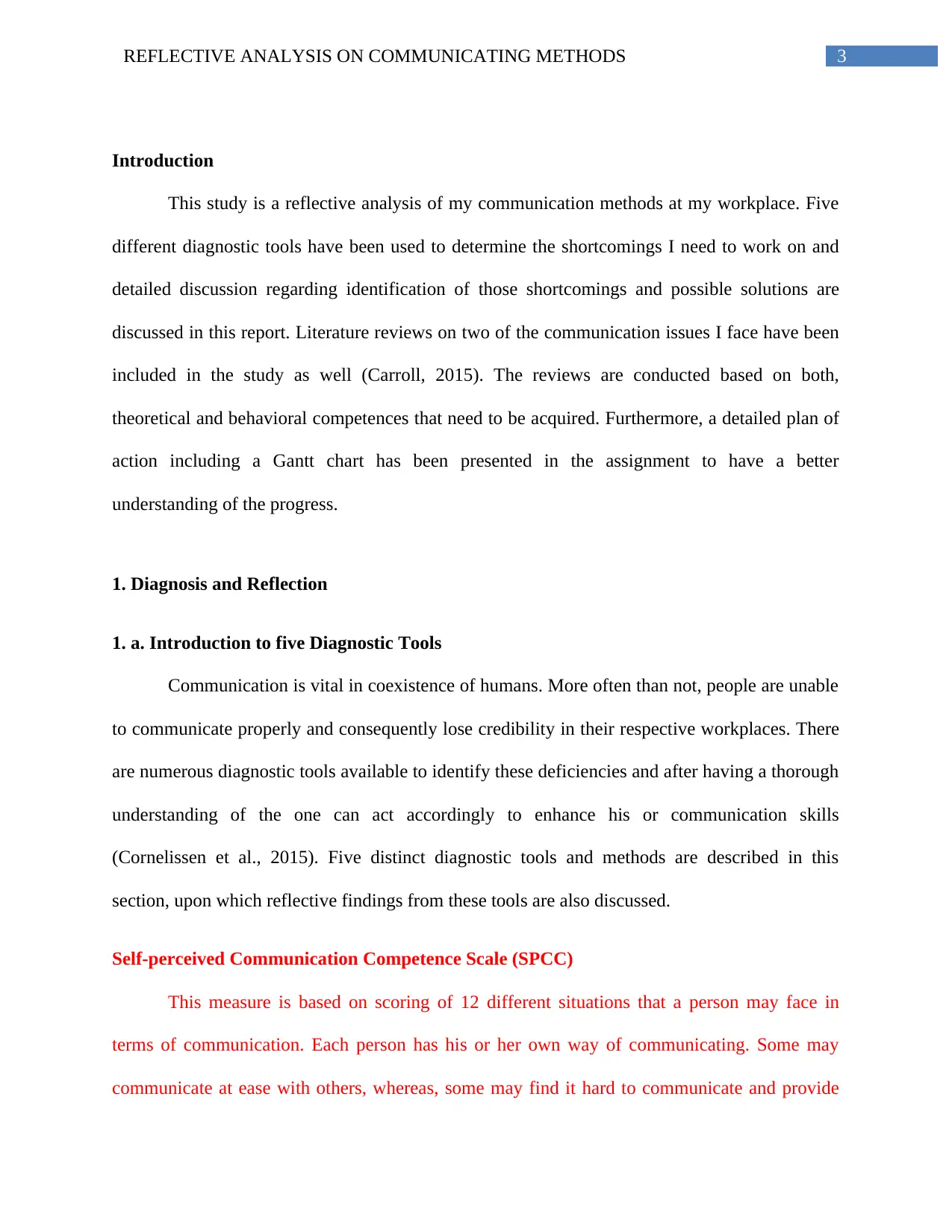
3REFLECTIVE ANALYSIS ON COMMUNICATING METHODS
Introduction
This study is a reflective analysis of my communication methods at my workplace. Five
different diagnostic tools have been used to determine the shortcomings I need to work on and
detailed discussion regarding identification of those shortcomings and possible solutions are
discussed in this report. Literature reviews on two of the communication issues I face have been
included in the study as well (Carroll, 2015). The reviews are conducted based on both,
theoretical and behavioral competences that need to be acquired. Furthermore, a detailed plan of
action including a Gantt chart has been presented in the assignment to have a better
understanding of the progress.
1. Diagnosis and Reflection
1. a. Introduction to five Diagnostic Tools
Communication is vital in coexistence of humans. More often than not, people are unable
to communicate properly and consequently lose credibility in their respective workplaces. There
are numerous diagnostic tools available to identify these deficiencies and after having a thorough
understanding of the one can act accordingly to enhance his or communication skills
(Cornelissen et al., 2015). Five distinct diagnostic tools and methods are described in this
section, upon which reflective findings from these tools are also discussed.
Self-perceived Communication Competence Scale (SPCC)
This measure is based on scoring of 12 different situations that a person may face in
terms of communication. Each person has his or her own way of communicating. Some may
communicate at ease with others, whereas, some may find it hard to communicate and provide
Introduction
This study is a reflective analysis of my communication methods at my workplace. Five
different diagnostic tools have been used to determine the shortcomings I need to work on and
detailed discussion regarding identification of those shortcomings and possible solutions are
discussed in this report. Literature reviews on two of the communication issues I face have been
included in the study as well (Carroll, 2015). The reviews are conducted based on both,
theoretical and behavioral competences that need to be acquired. Furthermore, a detailed plan of
action including a Gantt chart has been presented in the assignment to have a better
understanding of the progress.
1. Diagnosis and Reflection
1. a. Introduction to five Diagnostic Tools
Communication is vital in coexistence of humans. More often than not, people are unable
to communicate properly and consequently lose credibility in their respective workplaces. There
are numerous diagnostic tools available to identify these deficiencies and after having a thorough
understanding of the one can act accordingly to enhance his or communication skills
(Cornelissen et al., 2015). Five distinct diagnostic tools and methods are described in this
section, upon which reflective findings from these tools are also discussed.
Self-perceived Communication Competence Scale (SPCC)
This measure is based on scoring of 12 different situations that a person may face in
terms of communication. Each person has his or her own way of communicating. Some may
communicate at ease with others, whereas, some may find it hard to communicate and provide
Paraphrase This Document
Need a fresh take? Get an instant paraphrase of this document with our AI Paraphraser
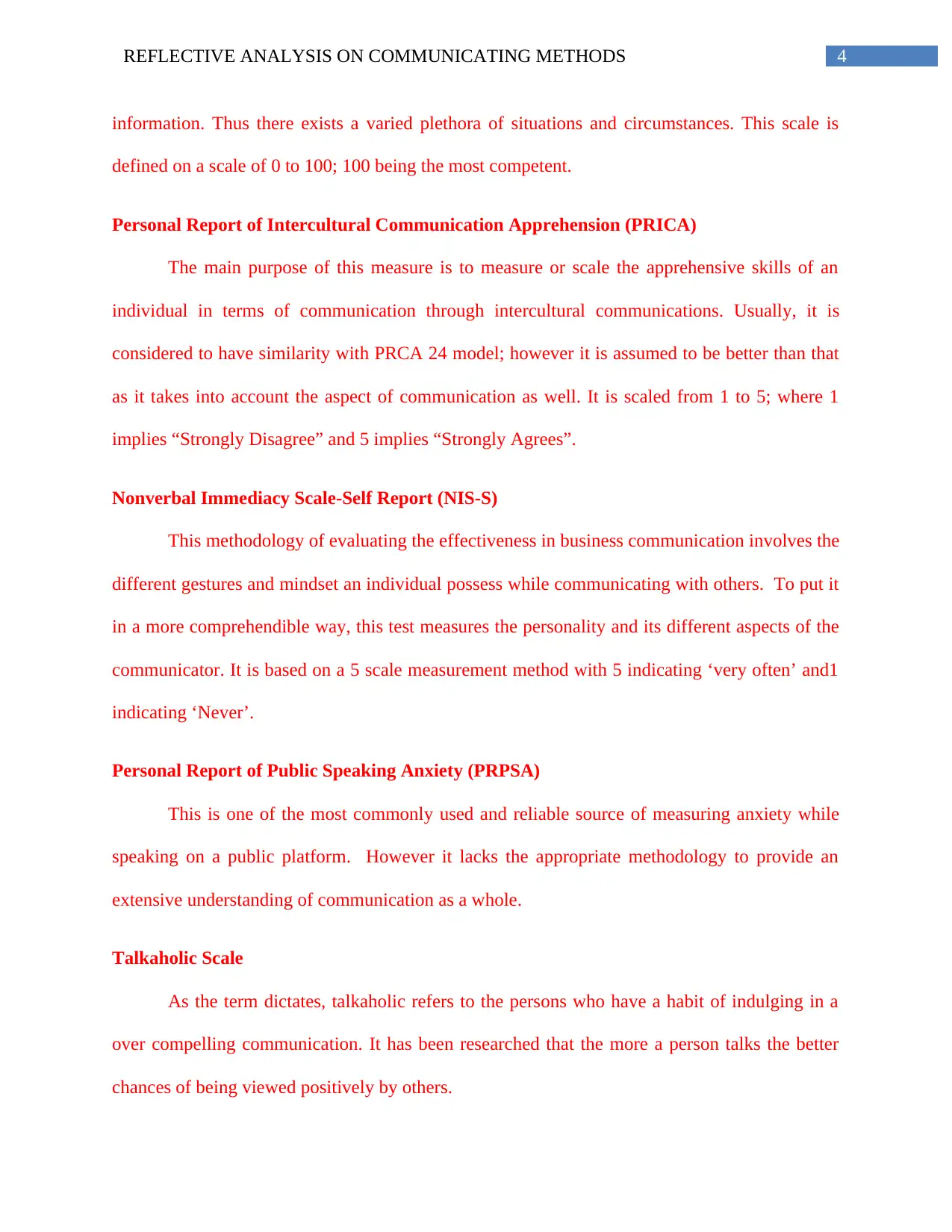
4REFLECTIVE ANALYSIS ON COMMUNICATING METHODS
information. Thus there exists a varied plethora of situations and circumstances. This scale is
defined on a scale of 0 to 100; 100 being the most competent.
Personal Report of Intercultural Communication Apprehension (PRICA)
The main purpose of this measure is to measure or scale the apprehensive skills of an
individual in terms of communication through intercultural communications. Usually, it is
considered to have similarity with PRCA 24 model; however it is assumed to be better than that
as it takes into account the aspect of communication as well. It is scaled from 1 to 5; where 1
implies “Strongly Disagree” and 5 implies “Strongly Agrees”.
Nonverbal Immediacy Scale-Self Report (NIS-S)
This methodology of evaluating the effectiveness in business communication involves the
different gestures and mindset an individual possess while communicating with others. To put it
in a more comprehendible way, this test measures the personality and its different aspects of the
communicator. It is based on a 5 scale measurement method with 5 indicating ‘very often’ and1
indicating ‘Never’.
Personal Report of Public Speaking Anxiety (PRPSA)
This is one of the most commonly used and reliable source of measuring anxiety while
speaking on a public platform. However it lacks the appropriate methodology to provide an
extensive understanding of communication as a whole.
Talkaholic Scale
As the term dictates, talkaholic refers to the persons who have a habit of indulging in a
over compelling communication. It has been researched that the more a person talks the better
chances of being viewed positively by others.
information. Thus there exists a varied plethora of situations and circumstances. This scale is
defined on a scale of 0 to 100; 100 being the most competent.
Personal Report of Intercultural Communication Apprehension (PRICA)
The main purpose of this measure is to measure or scale the apprehensive skills of an
individual in terms of communication through intercultural communications. Usually, it is
considered to have similarity with PRCA 24 model; however it is assumed to be better than that
as it takes into account the aspect of communication as well. It is scaled from 1 to 5; where 1
implies “Strongly Disagree” and 5 implies “Strongly Agrees”.
Nonverbal Immediacy Scale-Self Report (NIS-S)
This methodology of evaluating the effectiveness in business communication involves the
different gestures and mindset an individual possess while communicating with others. To put it
in a more comprehendible way, this test measures the personality and its different aspects of the
communicator. It is based on a 5 scale measurement method with 5 indicating ‘very often’ and1
indicating ‘Never’.
Personal Report of Public Speaking Anxiety (PRPSA)
This is one of the most commonly used and reliable source of measuring anxiety while
speaking on a public platform. However it lacks the appropriate methodology to provide an
extensive understanding of communication as a whole.
Talkaholic Scale
As the term dictates, talkaholic refers to the persons who have a habit of indulging in a
over compelling communication. It has been researched that the more a person talks the better
chances of being viewed positively by others.
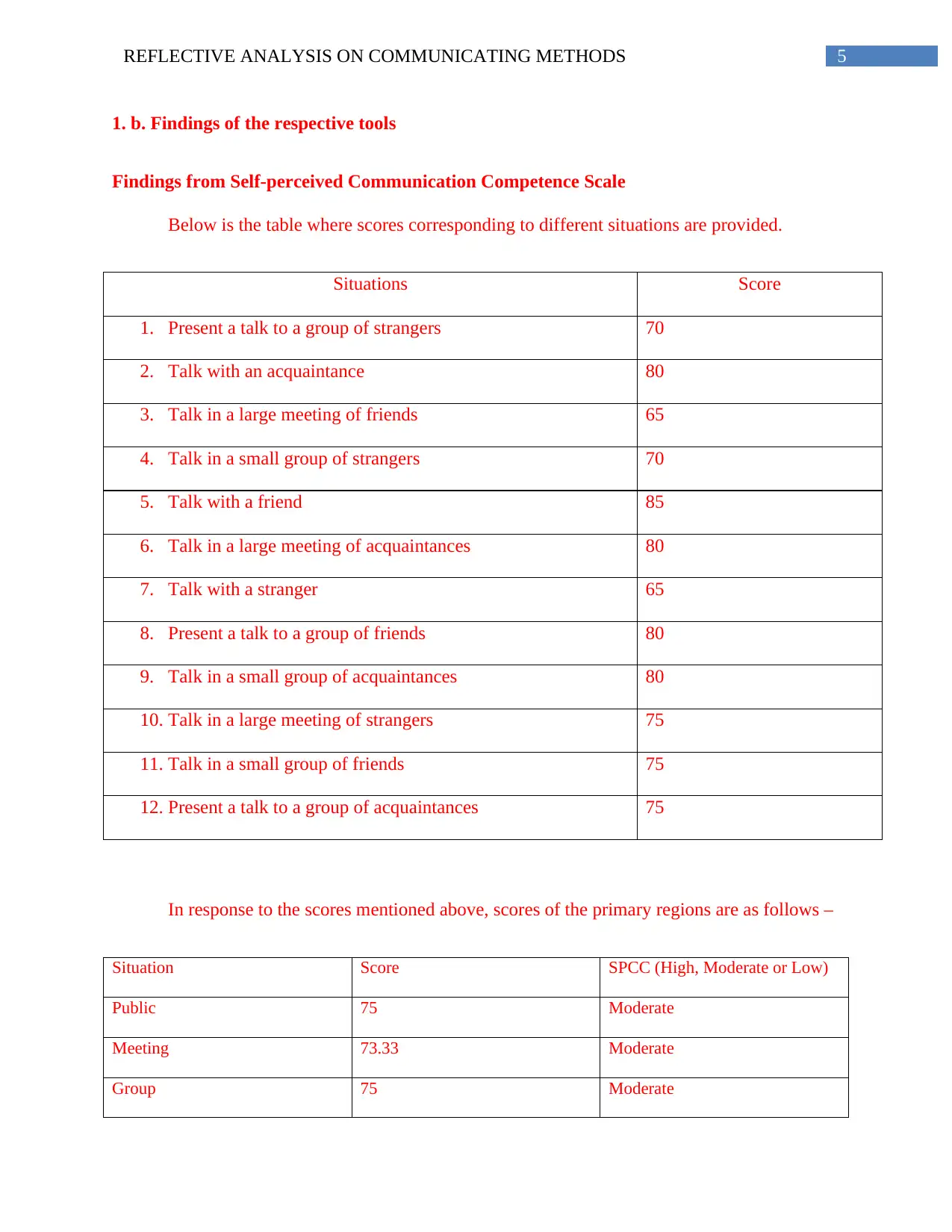
5REFLECTIVE ANALYSIS ON COMMUNICATING METHODS
1. b. Findings of the respective tools
Findings from Self-perceived Communication Competence Scale
Below is the table where scores corresponding to different situations are provided.
Situations Score
1. Present a talk to a group of strangers 70
2. Talk with an acquaintance 80
3. Talk in a large meeting of friends 65
4. Talk in a small group of strangers 70
5. Talk with a friend 85
6. Talk in a large meeting of acquaintances 80
7. Talk with a stranger 65
8. Present a talk to a group of friends 80
9. Talk in a small group of acquaintances 80
10. Talk in a large meeting of strangers 75
11. Talk in a small group of friends 75
12. Present a talk to a group of acquaintances 75
In response to the scores mentioned above, scores of the primary regions are as follows –
Situation Score SPCC (High, Moderate or Low)
Public 75 Moderate
Meeting 73.33 Moderate
Group 75 Moderate
1. b. Findings of the respective tools
Findings from Self-perceived Communication Competence Scale
Below is the table where scores corresponding to different situations are provided.
Situations Score
1. Present a talk to a group of strangers 70
2. Talk with an acquaintance 80
3. Talk in a large meeting of friends 65
4. Talk in a small group of strangers 70
5. Talk with a friend 85
6. Talk in a large meeting of acquaintances 80
7. Talk with a stranger 65
8. Present a talk to a group of friends 80
9. Talk in a small group of acquaintances 80
10. Talk in a large meeting of strangers 75
11. Talk in a small group of friends 75
12. Present a talk to a group of acquaintances 75
In response to the scores mentioned above, scores of the primary regions are as follows –
Situation Score SPCC (High, Moderate or Low)
Public 75 Moderate
Meeting 73.33 Moderate
Group 75 Moderate
⊘ This is a preview!⊘
Do you want full access?
Subscribe today to unlock all pages.

Trusted by 1+ million students worldwide
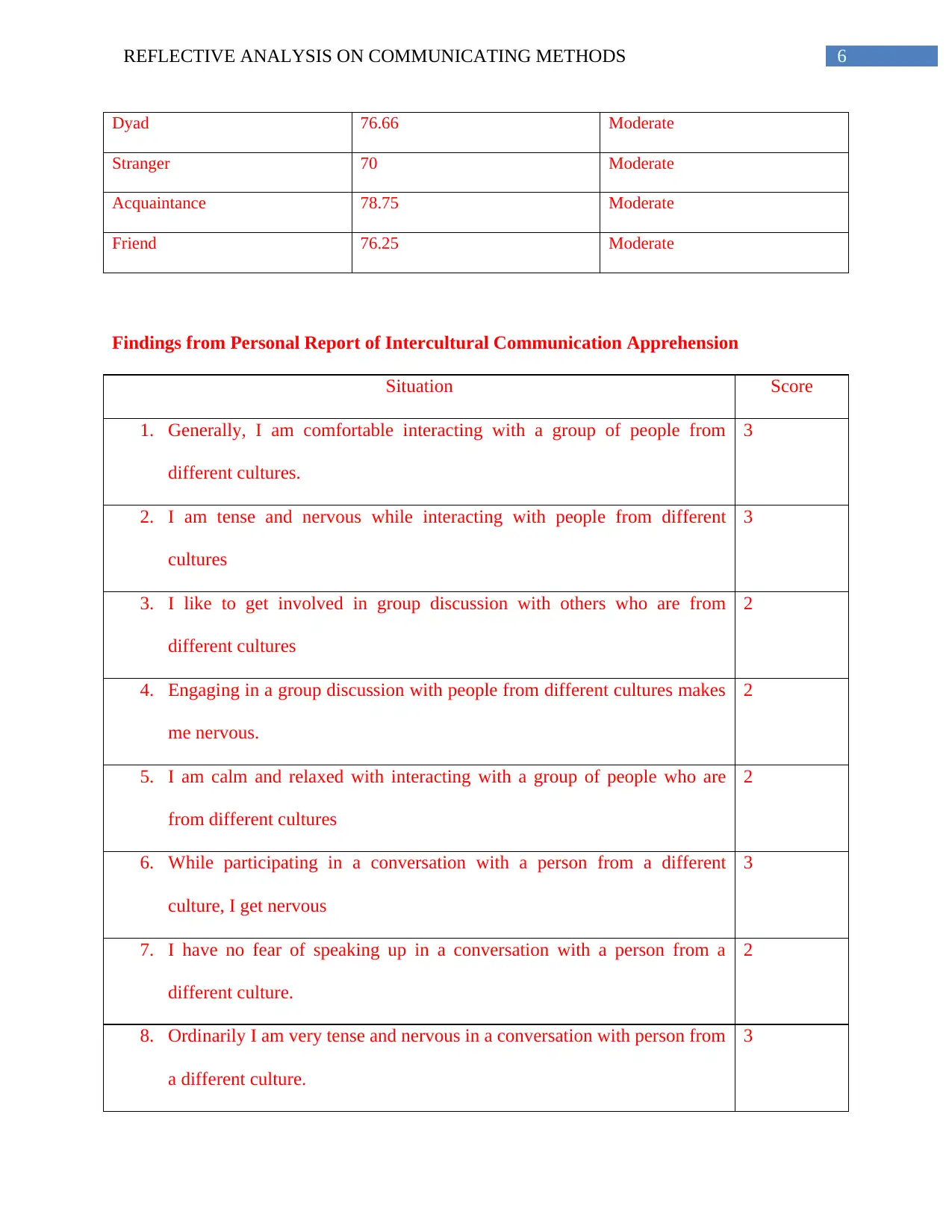
6REFLECTIVE ANALYSIS ON COMMUNICATING METHODS
Dyad 76.66 Moderate
Stranger 70 Moderate
Acquaintance 78.75 Moderate
Friend 76.25 Moderate
Findings from Personal Report of Intercultural Communication Apprehension
Situation Score
1. Generally, I am comfortable interacting with a group of people from
different cultures.
3
2. I am tense and nervous while interacting with people from different
cultures
3
3. I like to get involved in group discussion with others who are from
different cultures
2
4. Engaging in a group discussion with people from different cultures makes
me nervous.
2
5. I am calm and relaxed with interacting with a group of people who are
from different cultures
2
6. While participating in a conversation with a person from a different
culture, I get nervous
3
7. I have no fear of speaking up in a conversation with a person from a
different culture.
2
8. Ordinarily I am very tense and nervous in a conversation with person from
a different culture.
3
Dyad 76.66 Moderate
Stranger 70 Moderate
Acquaintance 78.75 Moderate
Friend 76.25 Moderate
Findings from Personal Report of Intercultural Communication Apprehension
Situation Score
1. Generally, I am comfortable interacting with a group of people from
different cultures.
3
2. I am tense and nervous while interacting with people from different
cultures
3
3. I like to get involved in group discussion with others who are from
different cultures
2
4. Engaging in a group discussion with people from different cultures makes
me nervous.
2
5. I am calm and relaxed with interacting with a group of people who are
from different cultures
2
6. While participating in a conversation with a person from a different
culture, I get nervous
3
7. I have no fear of speaking up in a conversation with a person from a
different culture.
2
8. Ordinarily I am very tense and nervous in a conversation with person from
a different culture.
3
Paraphrase This Document
Need a fresh take? Get an instant paraphrase of this document with our AI Paraphraser

7REFLECTIVE ANALYSIS ON COMMUNICATING METHODS
9. Ordinarily I am very calm and relaxed in conversations with a person
from a different culture
4
10. While conversing with a person from a different culture, I feel very
relaxed
3
11. I am afraid to speak up in conversations with a person from a different
culture
1
12. I face the prospect of interacting with people from different cultures with
confidence
4
13. My thoughts become confused and jumbled when interacting with people
from different cultures
2
14. Communicating with people from different cultures makes me feel
uncomfortable
1
Thus the PRICA score = 42 – 20+15 = 7
Findings from Nonverbal Immediacy Scale-Self Report
The output of the results is as shown below.
Situation Score
1. I use my hands and arms to gesture while talking
to people.
4
2. I touch others on the shoulder or arm while
talking to them.
2
3. I use a monotone or dull voice while talking to 2
9. Ordinarily I am very calm and relaxed in conversations with a person
from a different culture
4
10. While conversing with a person from a different culture, I feel very
relaxed
3
11. I am afraid to speak up in conversations with a person from a different
culture
1
12. I face the prospect of interacting with people from different cultures with
confidence
4
13. My thoughts become confused and jumbled when interacting with people
from different cultures
2
14. Communicating with people from different cultures makes me feel
uncomfortable
1
Thus the PRICA score = 42 – 20+15 = 7
Findings from Nonverbal Immediacy Scale-Self Report
The output of the results is as shown below.
Situation Score
1. I use my hands and arms to gesture while talking
to people.
4
2. I touch others on the shoulder or arm while
talking to them.
2
3. I use a monotone or dull voice while talking to 2

8REFLECTIVE ANALYSIS ON COMMUNICATING METHODS
people.
4. I look over or away from others while talking to
them.
3
5. I move away from others when they touch me
while we are talking.
2
6. I have a relaxed body position when I talk to
people.
4
7. I frown while talking to people. 2
8. I avoid eye contact while talking to people. 2
9. I have a tense body position while talking to
people.
3
10. I sit close or stand close to people while talking
with them.
2
11. My voice is monotonous or dull when I talk to
people.
2
12. I use a variety of vocal expressions when I talk
to people.
3
13. I gesture when I talk to people. 4
14. I am animated when I talk to people. 2
15. I have a bland facial expression when I talk to
people.
3
16. I move closer to people when I talk to them. 1
17. I look directly at people while talking to them. 2
people.
4. I look over or away from others while talking to
them.
3
5. I move away from others when they touch me
while we are talking.
2
6. I have a relaxed body position when I talk to
people.
4
7. I frown while talking to people. 2
8. I avoid eye contact while talking to people. 2
9. I have a tense body position while talking to
people.
3
10. I sit close or stand close to people while talking
with them.
2
11. My voice is monotonous or dull when I talk to
people.
2
12. I use a variety of vocal expressions when I talk
to people.
3
13. I gesture when I talk to people. 4
14. I am animated when I talk to people. 2
15. I have a bland facial expression when I talk to
people.
3
16. I move closer to people when I talk to them. 1
17. I look directly at people while talking to them. 2
⊘ This is a preview!⊘
Do you want full access?
Subscribe today to unlock all pages.

Trusted by 1+ million students worldwide
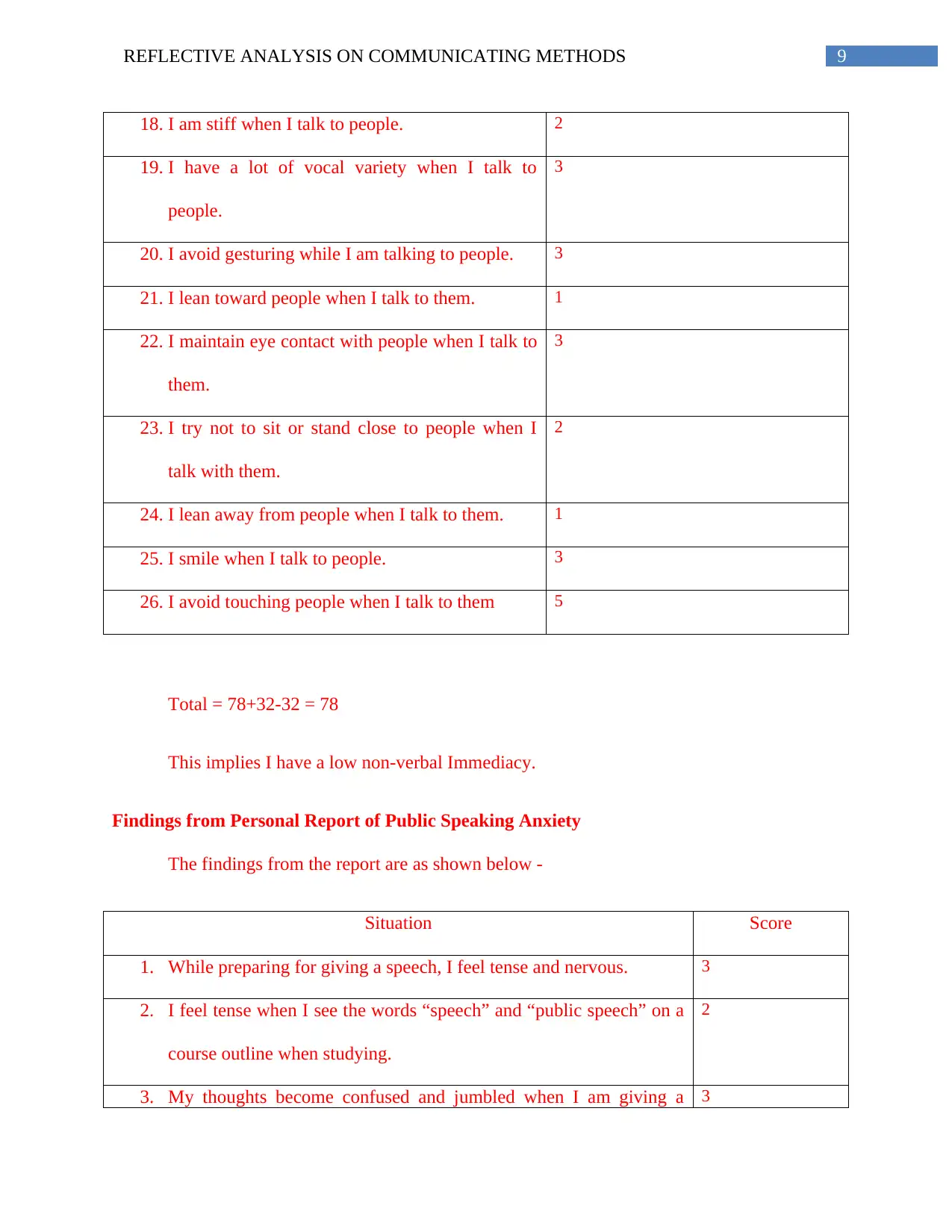
9REFLECTIVE ANALYSIS ON COMMUNICATING METHODS
18. I am stiff when I talk to people. 2
19. I have a lot of vocal variety when I talk to
people.
3
20. I avoid gesturing while I am talking to people. 3
21. I lean toward people when I talk to them. 1
22. I maintain eye contact with people when I talk to
them.
3
23. I try not to sit or stand close to people when I
talk with them.
2
24. I lean away from people when I talk to them. 1
25. I smile when I talk to people. 3
26. I avoid touching people when I talk to them 5
Total = 78+32-32 = 78
This implies I have a low non-verbal Immediacy.
Findings from Personal Report of Public Speaking Anxiety
The findings from the report are as shown below -
Situation Score
1. While preparing for giving a speech, I feel tense and nervous. 3
2. I feel tense when I see the words “speech” and “public speech” on a
course outline when studying.
2
3. My thoughts become confused and jumbled when I am giving a 3
18. I am stiff when I talk to people. 2
19. I have a lot of vocal variety when I talk to
people.
3
20. I avoid gesturing while I am talking to people. 3
21. I lean toward people when I talk to them. 1
22. I maintain eye contact with people when I talk to
them.
3
23. I try not to sit or stand close to people when I
talk with them.
2
24. I lean away from people when I talk to them. 1
25. I smile when I talk to people. 3
26. I avoid touching people when I talk to them 5
Total = 78+32-32 = 78
This implies I have a low non-verbal Immediacy.
Findings from Personal Report of Public Speaking Anxiety
The findings from the report are as shown below -
Situation Score
1. While preparing for giving a speech, I feel tense and nervous. 3
2. I feel tense when I see the words “speech” and “public speech” on a
course outline when studying.
2
3. My thoughts become confused and jumbled when I am giving a 3
Paraphrase This Document
Need a fresh take? Get an instant paraphrase of this document with our AI Paraphraser
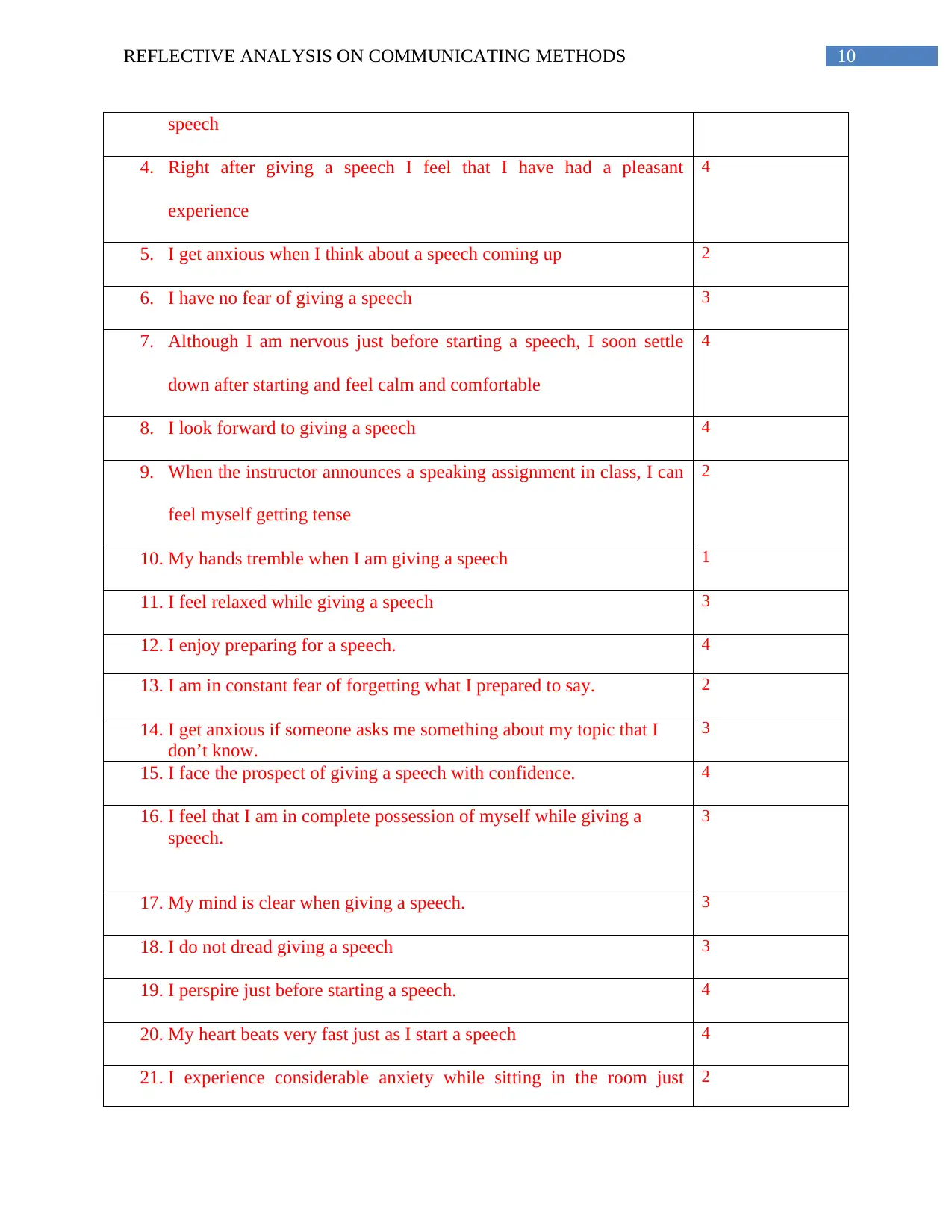
10REFLECTIVE ANALYSIS ON COMMUNICATING METHODS
speech
4. Right after giving a speech I feel that I have had a pleasant
experience
4
5. I get anxious when I think about a speech coming up 2
6. I have no fear of giving a speech 3
7. Although I am nervous just before starting a speech, I soon settle
down after starting and feel calm and comfortable
4
8. I look forward to giving a speech 4
9. When the instructor announces a speaking assignment in class, I can
feel myself getting tense
2
10. My hands tremble when I am giving a speech 1
11. I feel relaxed while giving a speech 3
12. I enjoy preparing for a speech. 4
13. I am in constant fear of forgetting what I prepared to say. 2
14. I get anxious if someone asks me something about my topic that I
don’t know.
3
15. I face the prospect of giving a speech with confidence. 4
16. I feel that I am in complete possession of myself while giving a
speech.
3
17. My mind is clear when giving a speech. 3
18. I do not dread giving a speech 3
19. I perspire just before starting a speech. 4
20. My heart beats very fast just as I start a speech 4
21. I experience considerable anxiety while sitting in the room just 2
speech
4. Right after giving a speech I feel that I have had a pleasant
experience
4
5. I get anxious when I think about a speech coming up 2
6. I have no fear of giving a speech 3
7. Although I am nervous just before starting a speech, I soon settle
down after starting and feel calm and comfortable
4
8. I look forward to giving a speech 4
9. When the instructor announces a speaking assignment in class, I can
feel myself getting tense
2
10. My hands tremble when I am giving a speech 1
11. I feel relaxed while giving a speech 3
12. I enjoy preparing for a speech. 4
13. I am in constant fear of forgetting what I prepared to say. 2
14. I get anxious if someone asks me something about my topic that I
don’t know.
3
15. I face the prospect of giving a speech with confidence. 4
16. I feel that I am in complete possession of myself while giving a
speech.
3
17. My mind is clear when giving a speech. 3
18. I do not dread giving a speech 3
19. I perspire just before starting a speech. 4
20. My heart beats very fast just as I start a speech 4
21. I experience considerable anxiety while sitting in the room just 2
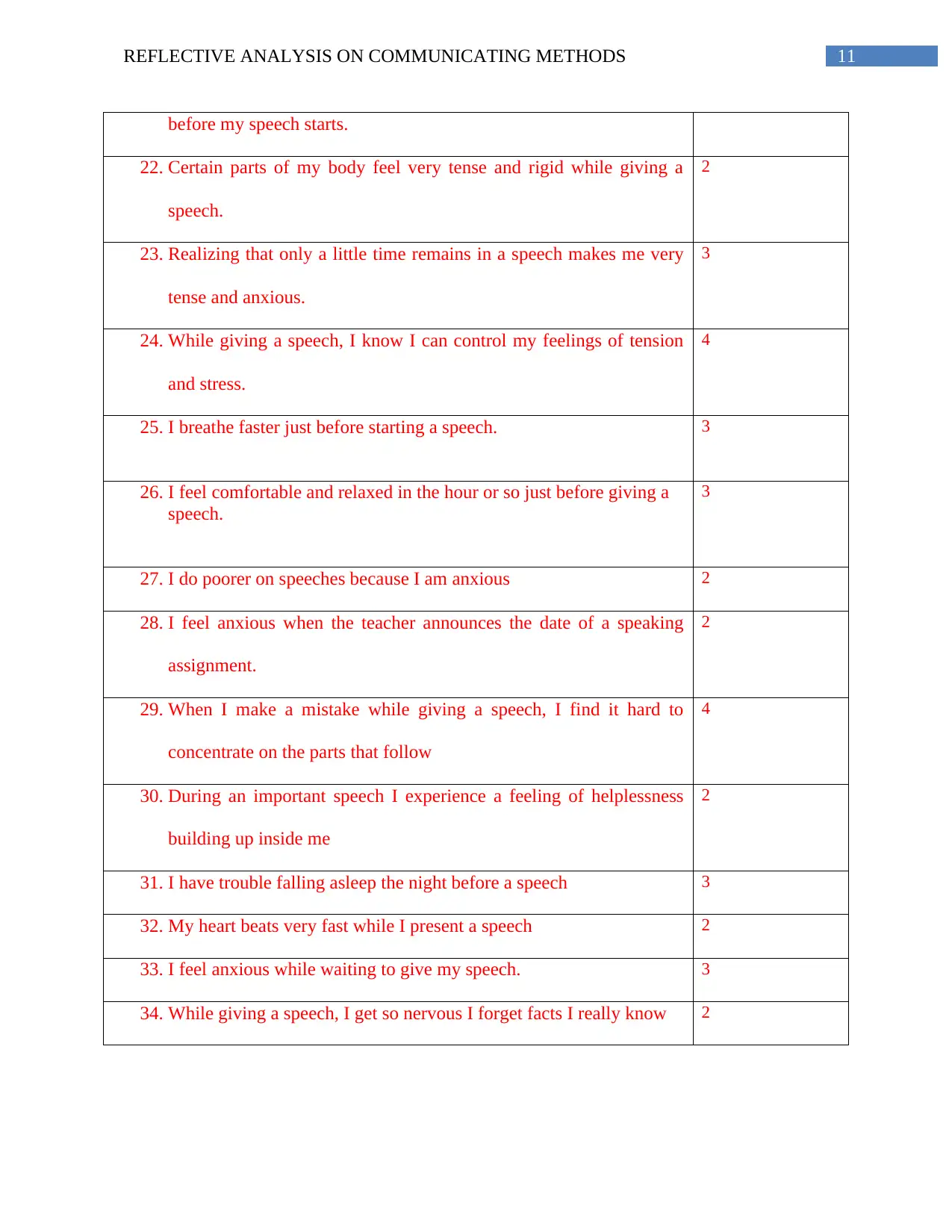
11REFLECTIVE ANALYSIS ON COMMUNICATING METHODS
before my speech starts.
22. Certain parts of my body feel very tense and rigid while giving a
speech.
2
23. Realizing that only a little time remains in a speech makes me very
tense and anxious.
3
24. While giving a speech, I know I can control my feelings of tension
and stress.
4
25. I breathe faster just before starting a speech. 3
26. I feel comfortable and relaxed in the hour or so just before giving a
speech.
3
27. I do poorer on speeches because I am anxious 2
28. I feel anxious when the teacher announces the date of a speaking
assignment.
2
29. When I make a mistake while giving a speech, I find it hard to
concentrate on the parts that follow
4
30. During an important speech I experience a feeling of helplessness
building up inside me
2
31. I have trouble falling asleep the night before a speech 3
32. My heart beats very fast while I present a speech 2
33. I feel anxious while waiting to give my speech. 3
34. While giving a speech, I get so nervous I forget facts I really know 2
before my speech starts.
22. Certain parts of my body feel very tense and rigid while giving a
speech.
2
23. Realizing that only a little time remains in a speech makes me very
tense and anxious.
3
24. While giving a speech, I know I can control my feelings of tension
and stress.
4
25. I breathe faster just before starting a speech. 3
26. I feel comfortable and relaxed in the hour or so just before giving a
speech.
3
27. I do poorer on speeches because I am anxious 2
28. I feel anxious when the teacher announces the date of a speaking
assignment.
2
29. When I make a mistake while giving a speech, I find it hard to
concentrate on the parts that follow
4
30. During an important speech I experience a feeling of helplessness
building up inside me
2
31. I have trouble falling asleep the night before a speech 3
32. My heart beats very fast while I present a speech 2
33. I feel anxious while waiting to give my speech. 3
34. While giving a speech, I get so nervous I forget facts I really know 2
⊘ This is a preview!⊘
Do you want full access?
Subscribe today to unlock all pages.

Trusted by 1+ million students worldwide
1 out of 23
Related Documents
Your All-in-One AI-Powered Toolkit for Academic Success.
+13062052269
info@desklib.com
Available 24*7 on WhatsApp / Email
![[object Object]](/_next/static/media/star-bottom.7253800d.svg)
Unlock your academic potential
Copyright © 2020–2025 A2Z Services. All Rights Reserved. Developed and managed by ZUCOL.



